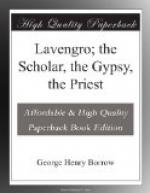nefarious man would be utterly forgotten; as it is,
he lives for ever in the pages of
Lavengro,
a hissing and a reproach. Authors have an ugly
trick of getting the better of their publishers in
the long run. After leaving London Borrow began
the wanderings described in
Lavengro and
The
Romany Rye. Those concluded, probably in
1829 or 1830, he crossed the British Channel, and
like another Goldsmith, wandered on foot over the
Continent of Europe, visiting France, Italy, Austria,
and Russia. Of his adventures in these countries
there is unhappily no record. In St. Petersburg
he must have made a long stay, for there he superintended
the translation of the Bible into Mandschu-Tartar,
and published in 1835 his
Targum;
or Metrical
Translations from Thirty Languages and Dialects.
In 1835 Borrow returned to London, and being already
known to the Bible Society for his biblical labours
in Russia, was offered, and accepted, the task of
circulating the Scriptures in the Spanish Peninsula.
As for his labours in this field, which occupied
him so agreeably for four or five years, are they not
narrated in
The Bible in Spain, a book first
published by ‘Glorious John Murray’ in
three volumes in 1843? This is the book which
made Borrow famous, though his earlier work,
The
Zincali;
or an Account of the Gypsies of Spain
(two vols. 1841), had attracted a good deal of notice.
But
The Bible in Spain took readers by storm,
and no wonder! Sir Robert Peel named it in the
House of Commons; its perusal imparted a new sensation,
the sensation of literature, to many a pious subscriber
to the Bible Society. The book, wherever it
went,—and it went where such like books
do not often go,—carried joy and rapture
with it. Young people hailed it tumultuously
and cherished it tenderly. There were four editions
in three volumes in the year of publication.
What was thought of the book by the Bible Society
I do not know. Perhaps ’he of the countenance
of a lion,’ of whom we read in the forty-fifth
chapter of
Lavengro, scarcely knew what to
say about it; but the precise-looking man with the
ill-natured countenance, no doubt, forbade his family
to read
The Bible in Spain.
In 1840 Borrow married the widow of a naval officer
and settled in Norfolk, where his aged mother was
still living. His house was in Oulton Broad;
and here he became a notable, the hero of many stories,
and the friend of man, provided he was neither literary
nor genteel. Here also he finished Lavengro
(1851), and wrote The Romany Rye (1857), Wild
Wales (1862), and Romano Lavo-Lil:
the Word-Book of the Romany (1874). For
a time Borrow had a house in London in Hereford Square,
where his wife died in 1869. He died himself
at Oulton in August 1881, leaving behind him, so it
is frequently asserted, many manuscript volumes, including
treatises on Celtic poetry, on Welsh and Cornish and
Manx literature, as well as translations from the Norse
and Russ and the jest-books of Turkey. Some,
at all events, of these works were advertised as ‘ready
for the press’ in 1858.




